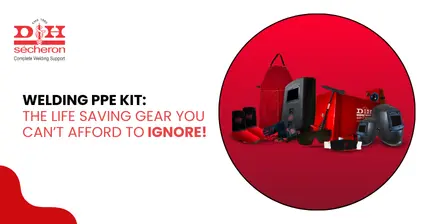Welding, as a profession, is looked at as unskilled work or labour. Of course, this is a big misbelief. The truth is the exact opposite of this misinformation. Welding is a job that requires in-depth knowledge of the field, along with the temperament and physical prowess to handle the mechanical nature of this work.
Any industry that requires two metal pieces, big or small, to be joined, needs welding; which is why welding is very important but is deeply misunderstood. Even large structures like bridges and statues owe their existence to welding.

It isn’t just the large structures, welding also plays a big role in our daily lives. How? By being a constant in fields like manufacturing, construction and infrastructure, transportation and military, to name a few.
Now that we have understood how welding affects our lives, we know that it is a necessity to ensure that welding education is a field that gets promoted and before that, understood well. It is not just a field that employs, it is a field that requires people who understand all its jargon and nuances. That requires welding education and training.
Welding two metals requires welding materials like welding electrodes, welding consumables and other things like cast iron welding rod, or other ferrous and non-ferrous metals and gases. These are heavy duty materials. It holds a lot of potential to go really wrong, really quickly.
An untrained, unskilled or ill-equipped professional will not be able to handle these welding materials properly. Neglecting safety concerns and precautions is extremely hazardous and will affect not just the quality of the weld but also the health of the welder and people around him or her.
To eliminate this concern, welding licensing and off-the-job training before one starts with their jobs or with their practice of welding helps. This safeguards all the people involved in this process- the welder, the employer and any others involved. In addition to this practice, certificates of previous work or training as well as referrals should be involved, just like any other industry or career.
Now, there exist around 30 types of welding, like, gas metal arc welding, tungsten inert gas welding, shielded metal arc welding, laser beam welding. Since all of them are very different from each other, each requires a certain amount of specialization, even if someone has a basic understanding of welding. This again reinforces as to why systematic education and training in welding is required.
Not just the specialization, but also the precautions that each type of welding would require are very different and all the professionals are expected to know these inside out. A welding certificate of having finished a certain level of education in it, shows that the specialization has been achieved, professionally and academically.
It also is proof on paper that the person has the capability to perform the welding as per a standard quality as well as inspect their own work, without involving other people.
The best way to go about this, is to find a school that offers at least a diploma course in the field of welding, before you kick-start your career in it. Like any other field, welding should be treated as a skill-based profession which requires a minimum standard of education and academic learning.
11 May 2025 | Welding
An In-Depth Exploration of Low-Alloy Steel: Your Comprehensive Guide
11 May 2025 | Welding
Nagpur - Bori - Tuljapur Road MSH-3 in Yavatmal District (Maharashtra)
11 May 2025 | Welding
Guidelines to Understand Gas Welding: Applications, Advantages & Disadvantages
11 May 2025 | Welding
3 Tips for Finding the Best Mild Steel Electrode for Your Application
11 May 2025 | Welding
How to Select the Right Welding Filler Wires for Stainless Steel Welding?
11 May 2025 | Welding
Building the Narendra Modi Stadium with Norma V and Autotherme-1 Electrodes
11 May 2025 | Welding
Low Alloy Steel Welding in a (PEB) Pre Engineered Building Structure
11 May 2025 | Welding
Welding Rods: Different Types and Tips for Properly Storing and Handling
11 May 2025 | Welding
Tips for Flawless Welds with Stainless Steel Electrodes: Pros and Cons
11 May 2025 | Welding
Exploring Applications and Benefits of Stainless Steel Welding Electrodes
11 May 2025 | Welding
Welding Basics: Joining Metals with Heat and Pressure - A Beginners Guide
11 May 2025 | Welding
Distinguishing Low-Alloy Steel from High-Alloy Steel: Understanding the Variations
11 May 2025 | Welding
Hard Facing Wire - Understanding the Process and Achieving Optimal Result
11 May 2025 | Welding
Exploring the Advantages of Stainless Steel Electrodes in Welding Applications
11 May 2025 | Welding
Weathering Steel vs. Traditional Steel: A Comparative Analysis of Performance
11 May 2025 | Welding
Choosing the Right Welding Rod: Why 6013 Electrodes Might Be Your Ideal Option
11 May 2025 | Welding
Why 7018 Electrodes Are Preferred for High-Strength Welds in Pipeline Construction
11 May 2025 | Welding
Filler Wire vs. Stainless Steel Filler Wire: Understanding the Key Differences
11 May 2025 | Welding
Exploring the Impact of Filler Material on Welding Quality and Durability
11 May 2025 | Welding
Choosing the Right Cast Iron Electrode for Different Welding Projects
11 May 2025 | Welding
Top Advantages of Cast Iron Electrodes for Industrial Welding Applications
11 May 2025 | Welding
Key Benefits and Challenges of Using TIG Welding in Industrial Projects
11 May 2025 | Welding
5 Reasons Why 7018 Electrode is the Gold Standard for Welding Professionals
11 May 2025 | Welding
Top 5 Advantages of Flux Cored Arc Welding for Heavy-Duty Applications.png)
11 May 2025 | Welding
Lotherme-601: A Game-Changer for Restoring Shoulder Pins in Heavy Machinery
11 May 2025 | Welding
How D&H Sécheron Helped Repair a Rotary Kiln’s Cooler Section with LoTherme 352
11 May 2025 | Welding
Piston Repair for Mining Industry: Cost-Effective Solutions with LoTherme 468.webp)






.jpg)







































.jpg)
.jpg)

.jpg)

.jpg)





.jpg)
.jpg)
.jpg)



.webp)
.jpg)
.jpg)
.webp)
.jpg)






















.png)



.webp)

.webp)
.webp)



